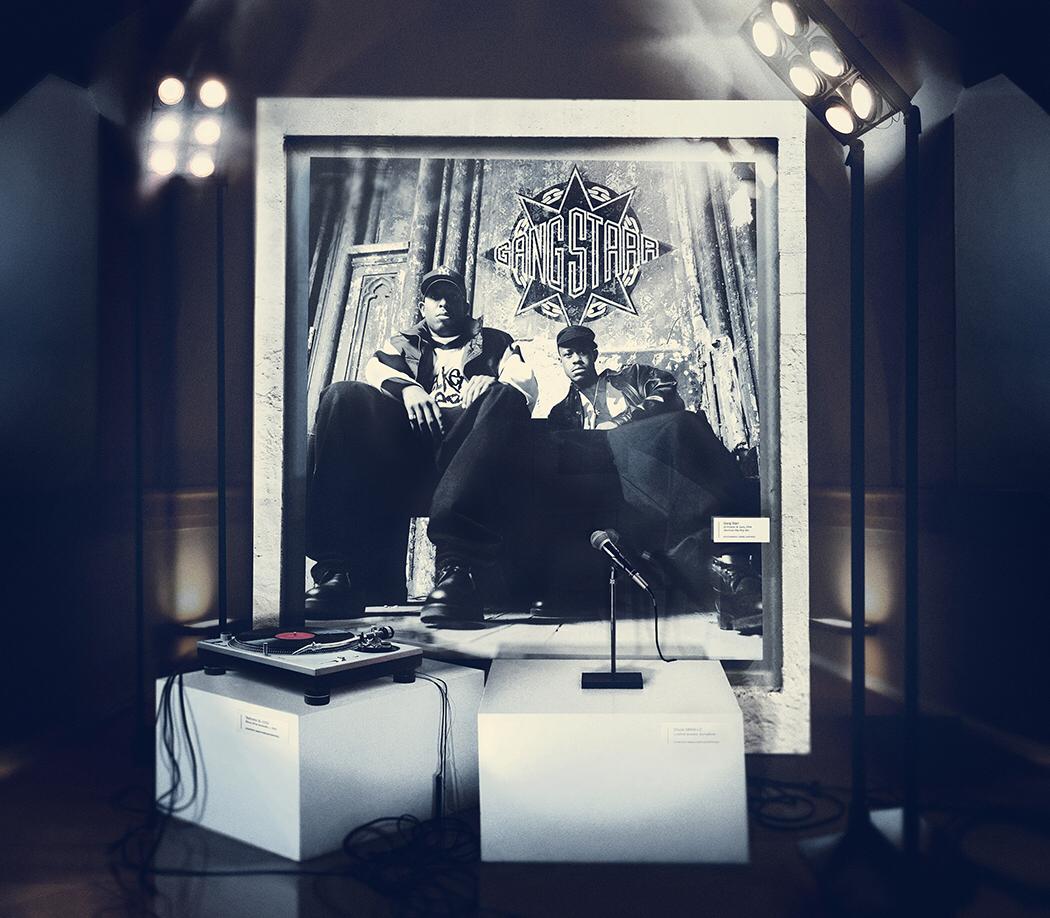
Posthumous albums are tricky for obvious reasons. Longtime fans want unheard material, but some things, especially from the venerated, may be better left alone. In the case of Gang Starr legend Guru, though, his voice is being resurrected by the only person who could do so: his partner of decades, DJ Premier.
Between Gang Starr’s first album, No More Mr. Nice Guy, and their fourth, Hard To Earn, the pair were roommates who lived an inseparable life of music and work. “We saw each other literally everyday for like five, six years. We were like beyond close. That’s why I was very nervous about doing this [album]” admits Preemo, who met Guru in the 1980s as a transplant from Texas. “But after I heard a few verses I knew it would be a Gang Starr album. I was all in.”
For decades, their bravado-laced, sonorous sound boomed from New York City, supported by radio play and buoyed by collaborations galore. For their new album, due to time, place, and circumstances, the approach was spiritual, even superstitious. DJ Premier burned sage in the studio before every session to remove “evil energy,” something he says he only recently started doing. The ethos and end goal of all involved—from M.O.P., to Freddie the Foxxx, to J. Cole—was to create an album that would make Guru proud. Preemo also made sure his partner’s presence emanated throughout the studio at all times, a decision that seems more personal than professional. “Guru’s urn was with us the entire time. It sat on a console underneath a poster of us. And next to it is a Gang Starr hat. This was the first Gang Starr project I had to do without him,” says Preemo, in Sotto voce. “I felt like I needed him there.”
One Of The Best Yet, the group’s seventh studio project, was teased months back on DJ Premier’s Twitter, through a clip of a voicemail from Nas asking, Yo, is it true there’s a new Gang Starr album? The answer was yes, and it arrived rather quickly thereafter. Features like Jeru the Damaja and Group Home—cats who’ve appeared with Gang Starr since the late ‘80s—add a heightened sense of completion, a bookend despite Preemo not denying the possibility that more Guru verses exist.
Speaking to The FADER over the phone, Preemo talks about his relationship with Guru and his family, touches on other Gang Starr projects, and fills in the gap leading up to the making of this latest one. DJ Premier and Guru will forever be connected, and hearing them together again just reinforces it.
One of the most memorable parts of the album is when Guru’s son says a few words about his father. How did that interlude come about?
“From A Distance” is a new one of the album where Guru starts his verse by saying, “It’s King Equality…” And if you’re speaking in Five-Nation of Islam language, “King Equality” stood for “Keith Elam,” it was his Five-Percent title. So I called his son and said, Hey you want to come by the studio and say a few words about your dad? I need a intro for this song. He said okay and already he had a little something written. There’s longer silences during his speaking parts that I edited down because he was getting emotional and kept pausing. I had to stop the whole thing a couple times to ask if he was okay. In terms of sequencing the album, it was a perfect interlude.
Sequencing has been an area of focus throughout your career. How do you approach it?
I’ve been sequencing all of my albums, from any Gang Starr stuff to Jeru to Group Home, all of it. I pay a lot of attention to that and really always have. I’ve even helped sequence friend’s projects. I basically sequenced Illmatic. It’s something I take a lot of joy and pride in from listening to Prince albums, or Pink Floyd, or The Isley Brothers, and Barry White. I’ve always cared about how certain songs fade into other ones and which songs should follow others. I studied that as a consumer and fan before I even got into music.
You had an urn in the studio while you were working on the album. What is the story behind how you attained Guru’s ashes?
His remains were brought to Boston after he died. I was at the funeral in Boston and his dad was conducting the service. I’ll never forget, his father was like, Chris, I need you and Sugar Bear—who is Big Shug—to be at the service and speak about my son because y’all were important people in his life. I witnessed some of the best days of my son’s life with this man... and he was pointing to me. So I was like, yes sir!.
How I got the ashes was that I was on tour in L.A. and reached out to Guru’s sister, Trish, to see if I can have just some of the ashes. I know that it was being held onto and I wanted to take some back with me to split between myself and Shug, since he also spoke at the funeral. It’s currently in a temporary urn, but I am having a custom made urn in the shape of a microphone very soon.
If you don’t mind, take us back to the moment when you found out about Guru’s passing.
I heard from Statik Selektah who called me at six in the morning and said, “Please tell me it isn’t true.” He said Guru’s publicist had posted it or whatever. So I said, hold on, let me call his father and sister. They heard the same thing but couldn’t confirm anything because there were issues with the hospital letting people up there. A little while later Guru’s brother confirmed it, so I let the world know.
Gang Starr's last album, The Ownerz, was sixteen years ago. What was your relationship with Guru like in the years after its release?
Well I’ve always done side projects. And Guru always did his own thing, too. It was never bad blood or anything. Even Guru’s Jazzmatazz series, I’ve been on all of them. I produced the Chaka Khan record on one of the Jazzmatazz projects as well as his Baldhead Slick project. We’ve always worked together even when Gang Starr was on a break. It was always: albums, tour, break, and repeat. I’ve stayed producing and it was a regular routine for us. So it was never a real separation, so to speak. We just did our own thing for a while.
Let's talk about the making of One Of The Best Yet. How did you feel once you decided to officially make another Gang Starr album?
I felt a lot of pressure to make Guru sound right over my beats, especially at this point in time.
What tracks on the new one standout to you as vintage sounding Gang Starr?
“Bless the Mic” reminded me of an old, '90s Step in the Arena-esque song and once that was done, I felt like it was on. “Bad Name” was next and I also felt like that hit right. It’s real short, just one verse and a hook done twice. But it started to feel like it an actual project we’d drop together.
Actually, for “Family & Loyalty” I wanted Drake on the track but he was about to go on tour for his Scorpion album, so timewise it wasn’t going to work. Out of this generation’s spitters, I really wanted Drake or Kendrick or Cole. I was about to reach out to Kendrick too but Cole had already been in the lab with me on some other shit so this just made sense.
Did you send J. Cole the song first?
Yes, but I had actually sent Cole another track I wanted him on. After some thinking, we decided it wasn’t the right one. So I kept working on all the songs and when it got closer towards the end of the album, that’s when I sent Cole the “Family & Loyalty” track. I actually texted him and he replied in like five minutes saying, I got the chills right now! How did you get Guru to sound like this? He said it was a done deal and that’s how that song happened.
How important was it to have all the members of Gang Starr Foundation on this album? These are friends and family but you guys haven’t worked together much since, right?
After I was able to make three good solid tracks for this new one, I felt like it was on. So I wanted to reunite everyone. I wanted to put all of our longstanding differences aside. I mean, we all had fist fights and stuff but we all were cool, especially after Guru passed. One of the last times we were all together was at his funeral. We had a big dinner and all made amends and hugged it out. We just haven’t recorded together in a while, but that was more reason to get everyone onboard. Everyone flew into town. Jeru flew in from Chile and wrote his verse on the plane. Group Home and Big Shug, that’s the Gang Starr Foundation, but it also extends to M.O.P., Bahamadia, and so many more Gang Starr extensions.
Were the beats from this album unfinished or unused Gang Starr songs? Or were they new ones you made after securing the vocals?
My formula from day one has always been to make the beat on the spot. In the era I was raised, everybody did it that way. You come to the studio with a sampler and records and make it on the spot. Plus, with these tracks, I had the vocals first, so my job was to match the beats to Guru. And I think they do match.
How did Q-Tip end up on "Hit Man"
Guru is so good at telling stories, so much so that you can vision everything he’s saying. So with that track, I knew I wanted someone like Tip on it to make it better, but not necessarily drop a verse. I actually just wanted him to do a hook. It worked out well because Tip recently had throat surgery so his voice was fucked up. But he wanted to hear the song anyways and when he did, he said, “The track is pretty grimy! Maybe my fucked up voice might work with this one!” And he sent a little hook he had did live on his phone for me to check out and I thought it was perfectly weird and fits.
As a producer, what are some of the things you would take into account when making a beat for Guru?
I take a lot of things into account. Guru had such a different voice from most people. Plus he had a Boston accent! So, I always made sure the beats were tailored to him. I mean, with any rapper I work with, I do my best to match as much as possible. But with Guru, he knew me so well we could make something out of nothing if we wanted. But the pressure was on me to do it right this time. And for Guru, I felt like in order for it to come out right, I had to find the right textures to make his voice sound prominent and keep it above the beats. Guru used to always call me a beat tailor because I’d make things fit tighter [laughs].
So, without giving too much away, will there be one more Gang Starr album after this?
You never know.
